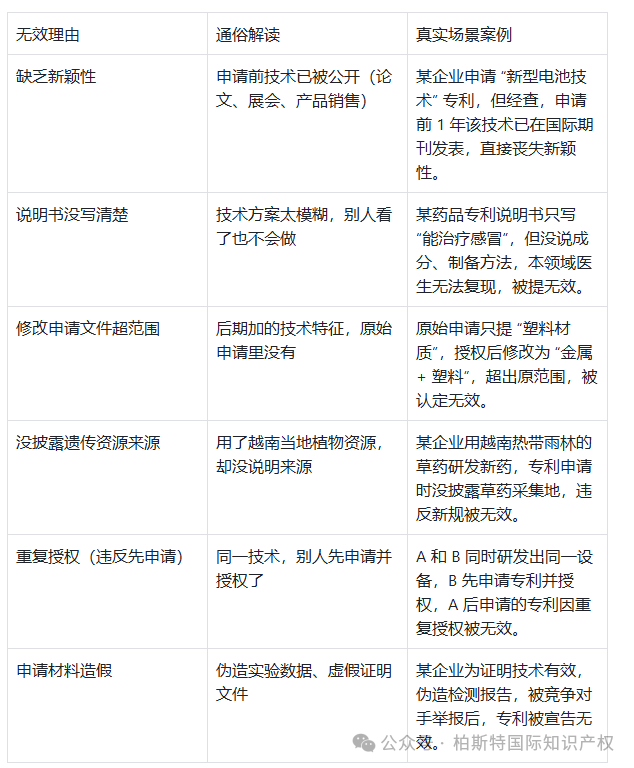- Knowledge
Preface
For companies planning to expand into the Vietnamese market or have already established patents locally, "patent invalidation" may be an unavoidable topic - either their own patents are challenged by competitors, or they need to break through their patent barriers through invalidation procedures. This article does not stack complex legal provisions, but uses a "scenario based practical guide" to quickly grasp the core points of Vietnamese patent invalidity.
1、 Who can propose invalidity? When will it be mentioned? (Key to activation)
1. Two types of "invalid applicants"
Stakeholders:The most common ones are competitors and accused infringers. For example, if Company A is sued by Company B for patent infringement and discovers that Company B's patent itself has problems, Company A can act as an "interested party" to invalidate it, which is equivalent to "cutting the bottom of the barrel".
Vietnamese Intellectual Property Office (VNIPO) examiner:Even if no one mentions it, VNIPO will proactively initiate invalidation procedures if serious defects (such as falsified application documents) are found in the authorized patents during subsequent reviews.
2. Provide invalid 'time windows'
Invention/Utility Model:You can raise it at any time after authorization, even if the patent is about to expire, as long as you discover problems, you can still challenge it.
DesignVNIPO will not be accepted within 5 years after the authorization announcement, unless there are special circumstances such as fraud.
2、 What situations can lead to a patent being invalidated? (Core Reason Case)
Vietnam updated its patent law in January 2023, adding many invalid grounds. Enterprises need to focus on the following six high-frequency scenarios:

3、 What is the process after a patent is invalidated? (6-step coping method)
Assuming your company's patent in Vietnam is invalidated, there is no need to panic. Follow these steps to proceed:
Step 1: Upon receiving the VNIPO notification, first check whether the materials are complete or not
VNIPO will first conduct a formal review: Has the requester submitted all the necessary documents (invalid reasons, evidence, payment vouchers)? If the materials are missing, VNIPO will ask the other party to make corrections. At this time, you can closely monitor the correction situation and see if the other party has any "insufficient evidence" loopholes.
Step 2:30: Submit your defense within 30 days, don't miss the deadline
After receiving the invalid request materials, a defense must be submitted within 30 natural days, with a focus on refuting the other party's reasons: for example, if the other party says "the technology has been disclosed", you can provide "the differences between the disclosed content and this patent", or prove "the disclosure time is after the application date".
Step 3: Evidence exchange, find out the opponent's trump card
VNIPO will forward your defense statement to the requester, who can provide additional evidence within 15 days; You can also see the other party's new evidence, and this step should focus on verifying the authenticity of the other party's evidence (such as whether the publication time of public literature is true).
Step 4: Should we have a hearing? Check the complexity of the case
Simple cases (such as obvious modifications beyond the scope):VNIPO written review, with results to be released within 3-6 months.
Complex cases (such as major technical disputes): A hearing will be held, where you can bring technical experts and lawyers to attend, debate face-to-face with the other party, and clarify technical details.
Step 5: Wait for VNIPO ruling, there are 3 types of results
All invalid:The patent does not exist from the beginning, and previous infringement lawsuits will also be terminated.
Partially invalid:Only invalid and problematic claims, the remaining parts remain valid.
Maintain effectiveness:The other party's invalidity reason is not valid, and your patent continues to be protected.
Step 6: Disagree with the ruling? Appeal to court within 30 days
If you are not satisfied with the results of VNIPO, you can appeal to the Vietnamese Intellectual Property Court within 30 days; If dissatisfied with the first instance judgment, one can still appeal to the Supreme Court of Vietnam, and the final judgment shall prevail.
4、 Three suggestions to avoid pitfalls in patent protection for enterprises in Vietnam
1. Application stage: Strengthen the foundation
Find an agency familiar with Vietnamese patent law to ensure that the instructions are written in detail (without hiding the technology) and the modifications do not exceed the scope, especially when using local genetic resources (such as plants and animals). It is necessary to disclose the source and avoid crossing the red line of the new regulations.
2. Being disqualified: Don't give up the opportunity for the 'hearing'
Many companies think that a written defense is sufficient, but in complex technical disputes, a hearing can help VNIPO understand your technological advantages more intuitively, such as demonstrating the difference between your technology and existing technology with physical objects, which is more convincing than words.
3. Proactively attacking: breaking down competitive barriers with ineffective programs
If competitors use "problematic patents" to hinder your market, you can proactively request invalidation: first conduct a patent search to find the "invalidity points" of the opponent's patent (such as novelty defects), and then collect solid evidence (public literature, sales records) to improve the success rate of invalidation.
5、 Final reminder
In recent years, Vietnam has become increasingly strict in protecting intellectual property rights, and patent invalidation is not only a "means of safeguarding rights", but also a "compulsory course" for enterprises to compete in the local market. It is recommended that companies regularly review their patents in Vietnam and identify the risk of invalidation in advance; At the same time, pay attention to the new regulations of VNIPO to avoid losses due to unfamiliarity with the rules. If encountering complex cases, priority should be given to selecting a team of lawyers with legal backgrounds from both China and Vietnam to ensure that the response strategy is more in line with local judicial practices.




